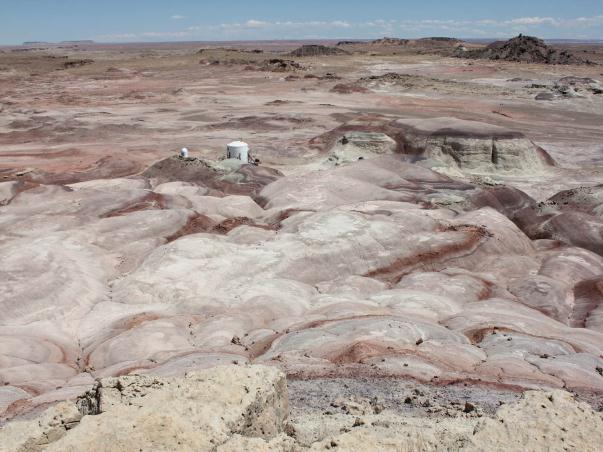Main menu
You are here
Home ›AMEC 2012 Report

Professor Ross Taylor gave the opening presentation (Photo: Rod Taylor)
As the Curiosity rover continued its solitary trek towards Mount Sharp, on a small blue planet some 300 million kilometres away, a group of engineers, scientists, and enthusiasts gathered to share their knowledge and passion for the exploration of Mars.
This was the twelfth annual conference of the Mars Society Australia, a non-profit research organisation dedicated to advancing the exploration and understanding of Mars. During the weekend the conference, held at the Canberra Southern Cross Club in Woden, brought together local and international speakers to present the latest Mars related research and outline possibilities for the future.
Professor Ross Taylor, a distinguished geochemist and planetary scientist from the Australian National University, presented the opening address entitled “Are We Alone?” Drawing on material from his ninth book, Destiny or Chance Revisited: Planets and Their Place in the Cosmos, Professor Taylor described the difficulties in locating planets with conditions similar to our own. In particular, he explained that whereas stars are relatively uniform in composition, there is enormous variability among planets, and even in our own solar system no two planets are alike.
He said that although the NASA Kepler Mission, which aims to find Earth-sized planets around other stars had identified well over 2,000 planet candidates, the enormous distances from Earth made planet candidate mass estimates unreliable and that even if planets with Earth-like mass were identified, this did not mean they had Earth like environments.
In relation to finding intelligent life within the universe, Professor Taylor said that with our planet being around 4.5 billion years old, and with radio communication only being available to us for a fraction of that time, we would have to be extremely lucky for another civilization to be at the same stage of technological evolution.
“There appear to be so many random chance events involved that it seems very unlikely that anything like us would have developed anywhere else in the universe,” he said.
Computer scientist Sean Moss demonstrated a website he is constructing called Moonmars.com. Designed to bring together space enthusiasts, students and professionals from around the world, this website will allow them to interact and access articles, papers, and space news. The most compelling feature of the website will be a virtual environment, containing models of the Moon and Mars, including settlements, vehicles and other equipment, and users will be able to explore their environment in spacesuits, drive vehicles and communicate with fellow adventurers.
Dr Duncan Steel, a space scientist who has worked with NASA to assess the threat of comet and asteroid collisions and investigate technologies to avert such impacts, put forward an imaginative proposal to explore Mars using a large number of small, inexpensive, self-sufficient robots, rather than continuing with the current approach of using one or two huge, costly rovers.
The massive expense of the Curiosity mission, estimated at $US 2.5 billion, meant the rover had to be landed in a safe, flat and smooth area so it would not be damaged. However, the geologically interesting areas, which may contain signs of liquid water, tend to have cliffs, rocky outcrops and steep slopes and are unsuitable for a conventional vehicle.
Dr Steel suggested that several hundred autonomous microbots, about the size of a football, could be dropped across a wide area of interesting geological features. These would contain cameras and small sensors, and would move a few centimetres per day, sending information back to an orbiting satellite. With their low cost, losing even a substantial number of these due to terrain difficulties would still be affordable and the working units would yield information that is inaccessible using today’s large rovers.
Steve Hobbs, who is completing a PhD with the University of New South Wales at ADFA reported on an innovative research project he conducted in the basin of Lake George, outside Canberra. Hobbs walked through the slopes on the western side of Lake George with a differential GPS unit, taking several thousand measurements of the topography and the gullies he found there. These gullies had been created by erosion from water flows, and were probably most active about 20,000 years ago, when the region experienced a severe temperature drop that killed off vegetation and made the land barren.
Armed with his Lake George data, Hobbs analysed the stereoscopic terrain images of gullies on Mars sent back by the Mars Reconnaissance Orbiter and compared them with those from Lake George. These matched the Lake George topography closely, adding support to the theory that there had been water flows on Mars in the recent geological past. One difference is that the gullies on Mars appear related to the melting of water rich mantles on the Martian slopes, rather than on rainfall.
New Zealand Mars Society president Haritina Mogosanu reported on her recent expedition to the NASA Mars Desert Research Station in Utah. With three men and two women from Australia and New Zealand she spent a fortnight in the facility which simulates what it would be like to live and work on Mars.
The main habitat is shaped like a rocket, and includes a greenhouse, waste water recycling plant, and small observatory. Participants wear “space suits” whenever they are outside, eat dehydrated astronaut food, live in extremely cramped conditions, and carry out a range of experiments and exercises.

NASA Mars Desert Research Station in Utah desert (Photo: Annalea Beattie)
Universities, science institutions and space agencies from all over the world use this facility to allow people to experience the challenges of limited communication with the outside world, and confined communal living in an inhospitable environment.
Mars Society ACT Branch President, Dr Jonathan Clarke, explained that a project is underway to build a similar facility in the Arkaroola region of the Northern Flinders Ranges of South Australia. In collaboration with Dr Liam Waldron from the Australian National University, third year engineering students have been participating in the interior and systems design of the Mars-OZ Analogue Research Station as part of their coursework.
This facility, structurally designed by Mars Society member and engineer David Willson, who is based at the NASA Ames Research Center in California, would allow Australians to share the experience of a simulated environment without the costs of travelling overseas and may encourage overseas researchers to undertake such work here.
The Utah expedition was extremely successful, with participants learning much about coping with difficult conditions, and they were able to share their experiences in real-time with school students via online messaging, webcams and webcasts.
Science consultant on the Australian Curriculum, Mark Gargano, discussed the decline in Year 12 science participation and how a focus on space science, astronomy, earth science, astrobiology, and hands-on activities might generate renewed interest.
In particular, the successful Spaceward Bound program developed by the NASA Ames Research Center, which allows students to participate in a two-week training and research mission at the Mars Desert Research Station, is an example of the kind of activity that should be encouraged.
Two Canberra film makers, Douglas Kirk and Andy Marriott from SilverSun Pictures, described their new feature film project entitled “The Mission”. This will be filmed entirely in Canberra next year, with a story that revolves around a mission to Mars. The four actors will be housed in a cramped spacecraft movie set for one month and during this time they will have no contact with the outside world. In this film experiment, which is part reality and part fiction, they will be directed and given scenarios over the spacecraft intercom system. The film will aim to convey the strength of the human spirit and explore what it means to be human.
Other aspects of the conference included a presentation on Australia’s space policy from the Department of Industry, Innovation, Science, Research and Tertiary Education, a robot demonstration, and an update on the Curiosity rover by Mars Survival Guide author Guy Murphy. And David Willson provided details of a possible new robotic Mars mission utilising the SpaceX Red Dragon capsule and new robotic drilling technology, which would greatly reduce the cost of Mars exploration and may definitively answer the question of whether life exists on Mars.
Thomas McCoy is a Canberra-based freelance science writer.

